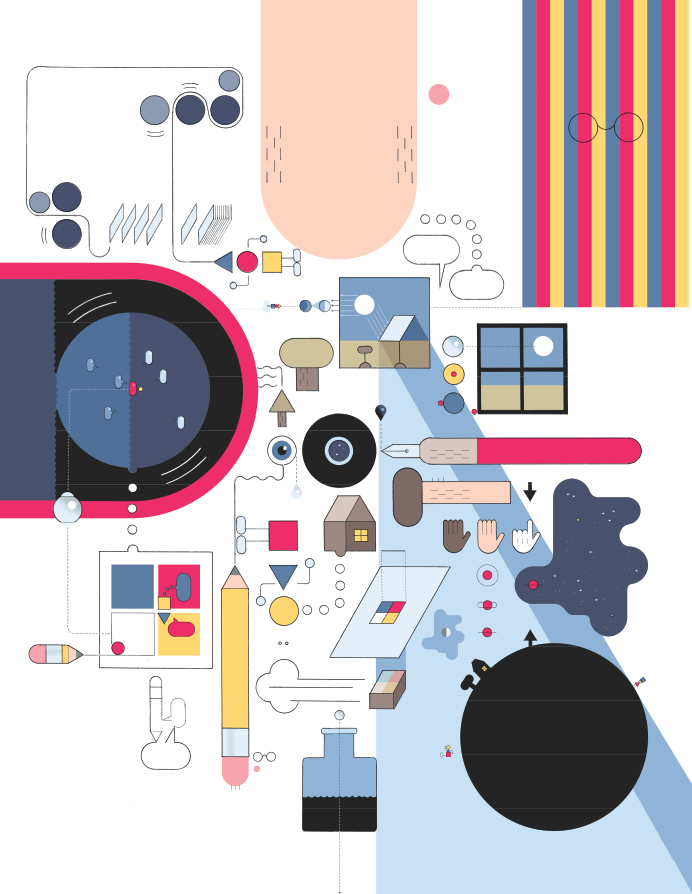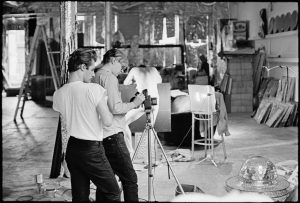The award-winning cartoonist meditates on the singular vitality of his art form

I am a cartoonist. And, as such, occasionally I will be asked by a normal civilian why, since I also appear to be a sensate, functioning adult, am I not just a regular writer, or a regular artist? Fortunately, this is a question I also ask myself about every two and a half minutes, so I am always prepared with a concise and perfectly sane-sounding answer.
We humans have a superhuman ability: to be able to see with our eyes closed. (Think of when we dream, or when we remember.) Even more remarkably, we can also see with our eyes open: such as when we daydream or remember while, say, driving a car. And as we worry about where we went wrong with our lives, ‘seeing’ memories that have happened to us or even fabricating pictures of things that might happen to us, we simultaneously experience our present reality, perhaps suddenly realising that a squirrel is in the road up ahead. Fortunately, the idea of a squirrel helps us to act quickly, even if that squirrel resolves into a wadded-up rag by the time we swerve around it.
Since the 600 words I’m exceeding here don’t allow for the usual summary of how comics became a viable medium of self-expression amid the higher arts of, say, writing and drawing, I’ll cut right to the word limit. Like words, pictures in comics are drawings that are not just meant to be looked at, but read. If this distinction seems strange, it’s similar to the way that the letterforms on this page of text aren’t meant to be scrutinised, but scanned. Like words, the images in comics are distilled and idealised, doodles – not drawings, even if one must also draw to make a doodle – that, I believe, mirror the mental templates, both visual and linguistic, we impose on reality to navigate and remember it. Congruently, as the reader of prose ‘hears’ words in an ineffable inner voice, the reader of comics ‘sees’ drawings that seem to come to life right on the page. It’s a little like reading sheet music and a lot less like watching a movie, but the results can be similarly magical.
Comics, as my lifelong friend Art Spiegelman has said, might also be considered the art of turning time back into space. For me, this wave-vs-particle notion means not only the possibility of seeing on one page all the moments of life at once, but also the difference between images-vs-words swerving around that rag-squirrel, and guesses at my future life, my regretted past, how that rag got in the road and the annoying advertisement on the car radio that distracted me into not seeing it sooner. Even better, all these experiences can, and should, be drawn by one person’s hand, and driven by one person’s mind and heart. The loneliness of Charles Schulz’s Charlie Brown broke my own heart as a kid, the empathy with which Schulz imbued his increasingly shaky doodles of the child he’d kept inside him his whole life making me want to do the same.
This aloneness – perhaps born of social anxiety, perhaps of artistic need (at a certain point it’s difficult to tell the difference) can lead to insights which are most possible to communicate in the process of the draw-writing of comics. I learned a long time ago that scripting a story before starting to draw it always led to it being dead on arrival. Only when I completely gave into the drawing itself and allowed the places and people that came out of nowhere (i.e. memory) to appear right in front of me did it all seem to suddenly come alive. It’s really no different from how one approaches life: you plan on living to an old age, you plan on driving to the store, but you also might have to swerve around some very unexpected things along the way. Living a rote, or even wrote life, isn’t living, it’s boring; one lives to try to understand not only oneself, but others, to try to feel through and especially feel for the people we encounter as life advances. Otherwise, what’s the point?
Vladimir Nabokov (a closet comics fan), in his lectures on James Joyce’s Ulysses, lamented the inability of the written word to capture the true full flow of experience; actual thought, he insisted, was not just words, but a flow of words and images together. Caitlin McGurk, a comics researcher and librarian at Ohio State University, found one day by closing her eyes and simply trying to see what her memories actually looked like – spurred by the fading recollections of her mother’s death when she was 12 – that they were little more than brief snippets of sound paired with even briefer bursts of vision, not the lengthy unedited brain-movies that we like to imagine we harbour. (In other words: comics. Try it yourself; you might be surprised.)
Nabokov also suggested, via his unreliable narrator of Lolita, that we all have a child buried alive within us. Contemporary culture apparently still likes to think that comics, in their juvenile semi-literacy, are a children’s form. I insist, however, that comics are incalculably more complicated, a super-literate language that can gather both the tangled linguistic shreds and the inchoate images of experience and blend them into the present, the possible future and remembered or revised past (aka fiction), all ideally composed so that the shapes of the accrued panels and pages (and, eventually, the books) can hint at the unseen strange and beautiful structures that govern and contain us. A synaesthetic, empathetic musical sensation of how it feels to be alive, brought back to life by a reader sitting alone in an armchair, for whom the artist/writer sat alone for years, carefully writing and drawing. That’s why I, at least, draw comics.




